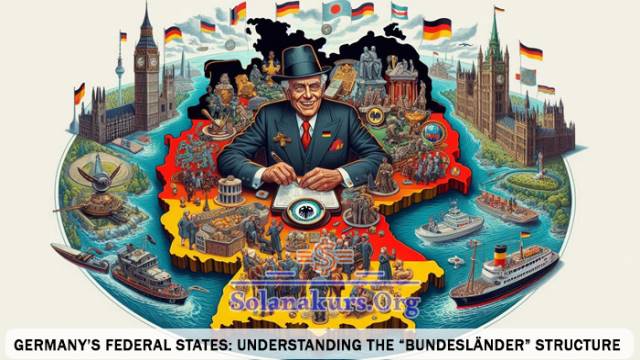Germany’s Federal States: Understanding the “Bundesländer” Structure

Germany, in the heart of Europe, is a country with a rich history, diverse culture and a strong economy. To understand Germany you need to understand its federal structure which is made up of 16 states called “Bundesländer”. These states are part of the country’s political, economic and social landscape. In this article we will look into the importance of the Bundesländer, their history and how they work within Germany’s federal system.
Problem: Bundesländer
Germany is seen as one country but many people don’t realize it’s a federal state. This means power is not only distributed at the national level but also at the state level. Each Bundesland has its own government, constitution and laws which can make Germany’s political system seem complicated to outsiders.
Agitation: Bundesländer
This federal system can be confusing especially for those who are used to more centralized governments. For example education, police and cultural affairs are managed by the individual states not the federal government. This means there can be big differences in these areas from one state to another. Understanding these differences is crucial for anyone who wants to do business in Germany, move there or even just visit. Without this knowledge navigating the country can be tough.
Solution: Bundesländer
In this article we will break down Germany’s federal system, focusing on the Bundesländer. We will look into their history, powers and responsibilities and how they fit into the bigger picture of German governance. By the end of this article you will have a better understanding of how Germany works as a federation of states and why this system is important.
The History of Germany’s Federal States
Germany’s federal structure has its roots deep in history. The concept of a federal system in Germany dates back to the Holy Roman Empire which was a collection of various territories and principalities. These regions had a lot of autonomy which laid the foundation for Germany’s federal structure.
After the fall of the Holy Roman Empire, Germany went through several transformations. In 1871 the German Empire was established and many independent states were united under one nation. But these states still had a lot of power especially in areas like education and law enforcement.
After World War II Germany was divided into East and West, each with its own government structure. West Germany (Federal Republic of Germany) adopted the federal system similar to today’s while East Germany (German Democratic Republic) was more centralized. After reunification of Germany in 1990 the federal system was extended to the former East German states.
The 16 Bundesländer: A Look Inside
Today Germany is divided into 16 Bundesländer, each with its own character and government. They vary greatly in size, population and economic power. Here’s a quick look at each:
- Baden-Württemberg: In the southwest, Baden-Württemberg is known for its strong economy, especially in the automotive industry. Stuttgart, the state capital, is home to Mercedes-Benz and Porsche.
- Bavaria (Bayern): Bavaria is the biggest state by land area. Famous for its cultural heritage, Oktoberfest and Bavarian architecture. Munich, the capital, is a major economic hub.
- Berlin: The capital of Germany, Berlin is also a state. Known for its history, arts scene and diversity.
- Brandenburg: Surrounding Berlin, Brandenburg is known for its natural beauty, many lakes and forests. More rural than Berlin.
- Bremen: The smallest state, Bremen consists of two cities: Bremen and Bremerhaven. An important port and trading centre.
- Hamburg: A major port city and one of Germany’s richest states. Big media and finance industry.
- Hesse (Hessen): In central Germany, Hesse is home to Frankfurt, the financial centre. Strong economy and high standard of living.
- Lower Saxony (Niedersachsen): Agricultural rich state with diverse economy. Hanover is the state capital, Volkswagen’s HQ is in Wolfsburg.
- Mecklenburg-Western Pomerania (Mecklenburg-Vorpommern): In the northeast, this state has a coastline along the Baltic Sea. Strong tourism industry.
- North Rhine-Westphalia (Nordrhein-Westfalen): The most populated state, North Rhine-Westphalia is an industrial giant. Cities like Cologne and Düsseldorf are major economic centres.
- Rhineland-Palatinate (Rheinland-Pfalz): Known for its wine production, Rhineland-Palatinate is in western Germany. Mainz is the state capital.
- Saarland: Near the French border, Saarland has a strong industrial base, especially in steel and automotive.
- Saxony (Sachsen): Saxony is famous for its cultural heritage, cities like Dresden and Leipzig played a big role in German history.
- Saxony-Anhalt (Sachsen-Anhalt): In central Germany, this state is known for its medieval architecture and historical sites.
- Schleswig-Holstein: In northern Germany, Schleswig-Holstein has a strong maritime economy and a beautiful coastline.
- Thüringen: Forests. Nicknamed the “Green Heart of Germany”. Capital: Erfurt.
Bundesländer Powers and Responsibilities
The Bundesländer have a lot of powers and responsibilities, as outlined in the German Basic Law (Grundgesetz). These powers are divided into three categories:
- Exclusive Powers: Some areas are exclusively controlled by the states. These include education, culture and police. This means each state can do as it likes in these areas, so there’s a lot of variation across the country.
- Concurrent Powers: In some areas both the federal government and the states have power. But if there’s a conflict, federal law takes precedence. Examples of concurrent powers are social welfare and public health.
- Federal Supervision: In some areas the states are responsible for implementing federal laws. This includes areas like immigration, where the federal government sets the laws, but the states are responsible for the enforcement.
The Bundesrat
Germany’s federal system is also reflected in its parliamentary structure. The Bundesrat, or Federal Council, represents the states at the federal level. Each state sends representatives to the Bundesrat where they can shape federal law. The number of representatives each state has is based on its population, more populous states have more votes.
The Bundesrat can approve or reject federal laws that affect the states. This gives the Bundesländer a lot of say in national policy, especially in areas like education, healthcare and infrastructure.
Economic Role of the Bundesländer
Germany is one of the biggest economies in the world and the Bundesländer play a big part in that. Each state has its own economic specialities which contribute to the overall economy. For example, Bavaria and Baden-Württemberg have the automotive and engineering industries, North Rhine-Westphalia has a big industrial base.
The economic differences between the states can be big. For example, the states in former East Germany, like Saxony and Thuringia, have lower GDPs and higher unemployment rates than the West. But the federal government has programs in place to promote economic development in these regions to reduce these gaps.
Challenges and Criticism of the Federal System
While Germany’s federal system has many advantages it also has challenges and criticism. One of the main criticism is that the system can lead to inefficiencies and lack of coordination. For example because education is controlled by the states there can be big differences in the quality of education across the country. This has led to calls for more federal control in certain areas.
Another challenge is the financial gap between the states. Some states, especially those in former East Germany, are less wealthy than others. This can lead to tensions between the states especially when it comes to federal financial transfers where wealthier states contribute more to support poorer states.
Despite all that Germany’s federal system is considered to be working well. It allows for a lot of regional self-administration and national unity. It also fosters diversity and innovation as the states can try out different policies and ways.
Conclusion
The Bundesländer are an integral part of Germany’s federal system. They have a lot of power and responsibility and can shape the policies and laws that affect their citizens. The system is complicated and sometimes criticized but it’s essential for Germany’s stability and prosperity. Knowing the Bundesländer is key to knowing Germany.
Bundesländer FAQs:
How many Bundesländer are there in Germany?
16
What do the Bundesländer do?
The Bundesländer have exclusive competences in areas like education, culture and police. They have concurrent competences with the federal government in areas like social welfare and public health.
How does the Bundesrat affect federal legislation?
The Bundesrat, or Federal Council, represents the states at federal level. It can approve or reject federal laws that affect the states, so the Bundesländer have a big say in national politics.




